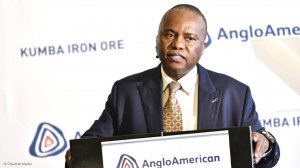JOHANNESBURG (miningweekly.com) – South Africa’s Kumba Iron Ore, which stands head and shoulders above its peers when it comes to iron-ore quality, is achieving major price premiums well above historical heights.
Structural change and strong growth in particularly the China steel market has placed the Anglo American company in pole position to receive record prices going forward. (Also watch attached Creamer Media video).
In response to the structural changes, Kumba has enhanced its product portfolio, with its lump-to-fine ratio increasing to 68% from a prior 66%.
This has allowed the company to take advantage of the strong lump premium in the markets.
Kumba has also lifted the average iron content of its products to 64.5% and as a result, its market share of premium lump ore, with more than 65% iron content and fine ore with above 64.5% iron content, more than doubled in 2018 to 30%.
“We aim to lift this further to 40%,” Kumba Iron Ore CE Themba Mkhwanazi told Mining Weekly Online.
It will do so by blending differently intermediate products from Sishen and Kolomela, its two iron-ore mines in the Northern Cape.
This focus on quality is helping the company to achieve better prices.
Quality-improving Kumba generated hefty operational cash flow, paid a generous 2018 cash dividend, pressed on with brownfield exploration in a new area and supported the creation of 2 600 new jobs in the local community during a fatality-free, safety-boosted year, characterised by higher prices for its products, better logistics and an improved relationship of cooperation with State rail enterprise Transnet.
Kumba exported 43.3-million tonnes of its sought-after product at an average price of $72/t, up from $71/t in 2017, to outperform its peers. The earnings before interest, taxes, depreciation and amortisation (Ebitda) margin rose by 3% to 45% on a Ebitda rise of 5% to R20.6-billion.
It has further diversified its customer portfolio, resulting in China now representing 56% of export sales, down from its two-thirds position of the past.
Price premiums measured against the Platts 62 free-on-board (fob) index have nearly trebled over the past three years to $17/t.
“Kumba continues to outperform its peers on fob realised prices,” Mkhwanazi told Mining Weekly Online.
Its lump-to-fine ratio is the highest in the industry, as is the average iron content of its products, making its average realised fob price of $72/t rise head and shoulders above those of its peers, with $2/t of the $72/t directly attributable to its quality focus.
The link between sales and operations has been strengthened to ensure that the production system is flexible and responsive to market changes and environmental protection demands.
Compared with the Platts 62 index price, Kumba’s realised prices widened from $6/t in 2015 to the current $17/t.
Kumba reduced its production by one-million tonnes between the second and third quarters of 2018, which offset high stock levels that fell from 6.6-million tonnes in the third quarter to 5.3-million tonnes in fourth quarter.
Chinese steel production rose for a second consecutive year to a record 928-million tonnes in 2018, buoyed 7% by investment in especially the property market.
New project starts, which were at the highest level after the global financial crisis of 2008, reached an all-time high.
Steel prices rose by 12% and high profitability incentivised mills to push for productivity gains.
On the supply side, for the first time in nearly two decades seaborne iron-ore supply contracted in 2018.
There were supply disruptions in Brazil, South Africa and Australia and 30-million tonnes of low-grade supplies exited the market.
Kumba Iron Ore, which is renowned for its quality ore, achieved exceptional price premiums for its lumpy iron-ore in 2018, when it received a record annual average of $0.25c/dry metric tonne unit (dmtu). Currently, the premium is $0.34/dmtu.
Going forward, Kumba expects the lump premium to remain well above historical average prices owing to tighter emissions controls in China, which not only escalates the cost of sintering but displaces sintering from direct charge ores.
Historically, the Platts 65 index traded at a 10% premium to the Platts 62 index but over the past two years this premium has increased sharply to 20% in 2017 and more than 30% in 2018.
This increase is believed to be driven by structural changes in the Chinese steel industry and as a result, Kumba expects this premium to average 20% going forward; firstly, because of the removal of 250-million tonnes of steelmaking capacity in China, which raised its 2018 steel capacity utilisation to 77%, with further increases targeted.
Secondly, capacity has been reduced mainly as a consequence of smaller blast furnaces being closed and bigger blast furnaces using a higher proportion of direct charge products and high-grade ores.
Thirdly, the share of the top ten steelmakers in China is expected to nearly double to 60%, which is supportive of steel pricing and mill margins in China.
Permission to expand Kolomela into the adjacent Heuningkranz area presents an “exciting” opportunity to extend the life-of-mine.
Mhkwanazi also talks of “significant value to unlock”, including the likely establishment of an ultra high dense media separation (UHDMS) plant to convert low-grade material, which is 68% complete and on track for approval in the last quarter of this year. The expected timing of production of the R2-billion to R3-billion UHDMS project is the last quarter of 2022.
EMAIL THIS ARTICLE SAVE THIS ARTICLE ARTICLE ENQUIRY
To subscribe email subscriptions@creamermedia.co.za or click here
To advertise email advertising@creamermedia.co.za or click here










